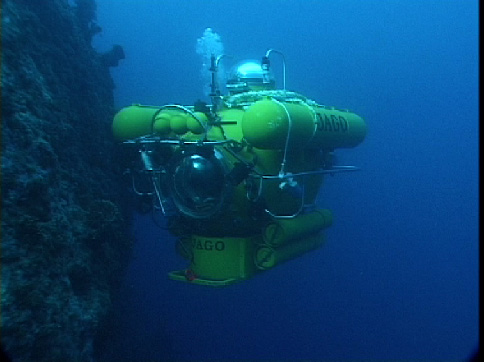 |
|
Latimeria chalumnae: The Coelacanth
The coelacanth
(pronounced SEE-la-kanth) is the lone survivor of an ancient line of lobe fin fishes thought to have been extinct for 60 to
70 million years. Their rediscovery, in 1938, caused great excitement and has been referred to as the "zoological find of
the twentieth century." After millions of years, they continue to remain relatively unchanged. Coelacanths are a close relative
of the fishes which first ventured onto land and gave rise to the tetrapods. An endangered species, coelacanths are believed
to number as few as 500-800 individuals along Grande Comore in the Comoros Islands. In the Comores, they inhabit steep volcanic
slopes ranging between 150 and 700 meters, with most sightings coming from the upper levels of this range. Coelacanths can
grow to nearly two meters in length and weigh close to 100 kg. Their most dramatic feature is their limb-like appendages.
The lobed pectoral and pelvic fins are quite unlike those of modern day fish. The second dorsal and anal fins are also lobed
and the caudal (tail) fin has three unique divisions. Coelacanths possess a fat filled air bladder and a flexible notochord,
which replaces the more common backbone. An unusual feature is the rostral organ in the snout, which may serve as an electroreceptor
for the coelacanth to monitor it's surroundings. Unique to the anatomy of modern creatures is the intercranial joint, a hinge
in the head, which widens the extension and strength of the bite. In contrast to most fishes, the coelacanth is ovoviviparous,
giving birth to live young.
Gombessa: The Comoros Islands and its Fishermen
In the Comoros Islands, coelacanths
inhabit an area off the west coast of Grande Comore and the island of Anjouan. In the past, coelacanths have been caught accidentally
by night fisherman using traditional deep hand line methods while seeking the oilfish, Ruvettus pretiosus. Most catches occur
in the range of 100-300 meters. Fishermen along Grande Comore have been particularly responsive to preserving their "Gombessa",
adopting a voluntary fishing ban in areas known to support concentrations of coelacanths. After years of dwindling numbers,
the population appears to be stable thanks to international trade restrictions and the voluntary fishing ban of the Comoros
fishermen. The fishermen should be commended and supported as much as possible in their efforts. They are trying to earn a
living under the most difficult and dangerous conditions--while doing their part to preserve a national treasure. Not only
is the coelacanth a treasure of the Comoros Islands, it is a treasure of our entire earth.
Coelacanth Conservation:
At Home and Abroad
The continuing cooperation of the Comoros fishermen is vital. The Association pour la Preservation
du Gombessa plans to make their ongoing support a priority. Educational efforts, both in the Comoros Islands and internationally,
are the foundation upon which the APG will achieve the goal to insure the future survival of the coelacanth. The United Nations
Convention on International Trade in Endangered Species (CITES) has afforded the coelacanth it's highest level of protection.
All international trade is now prohibited. Strict regulation, along with worldwide education, may help insure the survival
of the coelacanth.
Before the dinosaurs, long before any creature walked on the land, coelacanths inhabited the seas.
Great extinctions came and passed. The dinosaurs disappeared forever. Countless other creatures disappeared. Coelacanths survived.
Ironically, after millions and millions of years, the coelacanths greatest challenge to survival may come in this century.
|
|
 |
|

Special thanks to Hans Fricke, and team members
Jürgen Schauer and Karen Hissmann for their help with the APG Website, in addition to many years of valuable work on behalf
of the coelacanth. Research Group Fricke was the first to observe and film coelacanths in their natural habitat. Much of what
we know today about living coelacanths has come from their important studies.

|
|
 |
|



